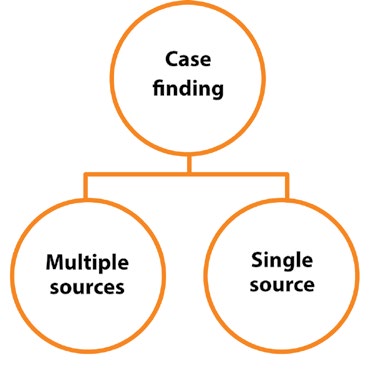3.3 Case Finding
‹View Table of Contents

Congenital anomalies surveillance programmes can decide the sources from which cases will be identified (see Fig. 3.5).
Data sources
Using multiple sources may improve the completeness of case ascertainment by identifying cases that are not available from only one individual source. Additionally, it may improve the quality of the data, as having multiple sources may increase the amount and level of information available for a given case. For example, a diagnosis may not be possible in the delivery unit but might be established by specialists in the pediatric unit and further confirmed by laboratory tests. While the use of multiple data sources is more time consuming and delays the process of gathering information, it can improve overall case ascertainment and data quality.
Using a single source for case ascertainment does not allow for ascertainment of the majority of fetuses or neonates with a congenital anomaly in most settings. For example, Fig. 3.6 depicts a marked under-ascertainment of NTDs in Puerto Rico when cases were ascertained from vital records alone, compared with case ascertainment from multiple sources (e.g. logbooks in the delivery room, neonatal care units, pediatric units) used by the Birth Defects Surveillance Programme.
Table of Contents
- Chapter 3: Approaches to Surveillance
- 3.1 Population Coverage
- 3.2 Case Ascertainment
- ›3.3 Case Finding
- 3.4 Case Inclusion
- 3.5 Description Formats for Congenital Anomalies
- 3.6 Age of Inclusion
- 3.7 Inclusion of Pregnancy Outcomes
- 3.8 Coding System
- 3.9 Potential Inclusion/Exclusion Criteria
- 3.10 Core Ascertainment Variables
- 3.11 Data-Collection Methods and Tools
- 3.12 Data Management and Protocols
- 3.13 Data Collection and Management